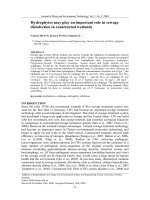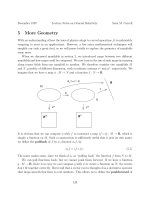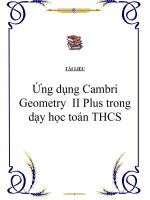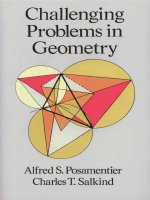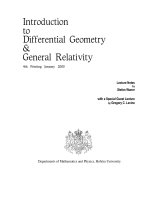Lets play geometry
Bạn đang xem bản rút gọn của tài liệu. Xem và tải ngay bản đầy đủ của tài liệu tại đây (14.34 MB, 136 trang )
let's play
GEOMETRY
L.N. Shevrin
VGZhitomirsky
Mir Publishers
Let's play
L.N. Shevrin
VGZhitomirsty
Mir Publishers
GEOMETRY
Translated from the Russian
by Alexander Repyev
Moscow
В. Г. Житомирский, JI. Н. Шеврин
ГЕОМЕТРИЯ ДЛЯ МАЛЫШЕЙ
Издательство «Педагогика»
Москва
First published 1985
Revised from the 1978 Russian edition
На английском
языке
©Издательство «Педагогика», 1978
©English translation, Mir Publishers, 1985
To our children
Igor and Anya Shevrin
Volodya an 4, Sasha Zhitomirsky
T O PARENTS
and Grandparents and the Adults
Who Will Read This Book
to Children
It is well known that authors always write prefaces after the body of
the book has been written. We are no exception to the rule and it was
only after the last page was ready that we set to the task of producing
the preface. But even before the first page had been turned out we knew
that we would have to formulate quite clearly the major points to be
included in the preface. After all, the preface is the right place for suggesting guidelines for those who would use the book to teach children.
We made a point of putting down in a separate notebook the ideas
worth reflecting in the preface. But when, the work over, we reread the
notebook all the way through, we realized that just listing these "ideas"
without expanding them would produce a "consistent" piece of preface.
So we reproduce them here as initially compiled:
The book is designed for children from 6 to 8 years old, but it might be of interest both to five-year olds and to older primary-school pupils.
The book can be used in any of the following ways: family reading, group
reading in Infants schools, and recreational reading in the lower Junior
schools.
The book is no study-book. It does not provide a systematic and complete introduction to geometry. Its aim is to acquaint children in an exciting and stimulating way with some of the principal concepts of geometry, to teach them
how to find bearings in simple geometrical situations and to discern geometrical patterns in the world around them.
4 Despite its "easiness", the book contains some fundamental scientific facts.
Therefore, using the book calls for active involvement on the part of adults.
At times it may be necessary to expand on those points that appear to be difficult, and to comment on the drawings and pictures emphasizing some
details.
Since the book contains many new ideas and facts, it should be read step by
step and the "dosage" should be reasonably graded. Granted the reading
"doses" are substantially dependent on the individual ability of a child, but
according to our experience a daily session should not be longer than 30-40
minutes (especially with group reading).
5
Each term for a new concept, when it first appears in the text, is printed in
red. It would pay to stop in those places, concentrating on the new term,
repeating it several times, checking and rechecking the response. It does not
matter if a child has not remembered all the new words and definitions at
once. What is more important is that he or she listen attentively and
understand.
It is a good practice to begin each session with recapitulation: recall the previous events and the definitions of the earlier concepts.
The tasks and the worksheets are important. They will make for a deeper understanding of the mathematical contents of the book and development of some practical skills with geometrical figures. Children should not
overlook these questions and exercises.
Some of the exercises are far more difficult than those inserted into the body
of the text. Some even introduce new concepts. It is up to the instructor to
decide whether or not the student can handle them and they should not insist
on carrying out the exercises in strict succession, especially if this will generate "adverse emotions" in the students.
Your sessions will require coloured pencils, paper, a ruler, a pair of scissors,
a pair of compasses, a set-square, sticks, and some Plasticine. All these
should be prepared beforehand and used as required.
With group reading, some sort of competition could be stimulated (who will
be the first to answer a question, or handle a task), or discussions conducted,
and so on. Such possibilities are not to be overlooked!
Enjoy the book!
The Authors
Moscow, 1984
Im
Pencil once invited the Happy
gang round to tea. The Happy
gang were his friends Pinocchio,
Dunno, and Gadgit. After tea he
said:
"Let's do some geometry. It's
very interesting."
"Let's!" said Gadgit and Dunno,
but Pinocchio asked:
"What's geo-mer-ty?"
"Not geomerty, but geometry,"
said Pencil. "Geometry-it's...
it's... I can't explain it at once.
Let's get started, and bit by bit
you'll learn everything."
The friends sat round the table.
"Well, look," said Pencil and pecked a sheet of paper with his
nose.
"What's it?"
"A point," said Gadgit.
"A point," echoed Dunno.
7
But Pinocchio said nothing, he just
poked his nose into some paint and
drummed with it quickly at a sheet of
paper... rat-a-tat-tat.
"And I've got many points!" cried out
Pinocchio.
"Don't hurry," Pencil stopped him
and put down another point on his
sheet.
"Now I've made two points."
"Two points," muttered Dunno and
also drew two points on his paper.
Gadgit also drew two points.
Now you draw two points on your sheet of paper.
8
Many points came to live
on Pinocchio's paper leaf
Pinocchio started to sing but was
hushed up by Pencil.
"Now I connect the points," said Pencil. "And I've got aline. You do the
same."
Dunno did this:
9
Gadgit this.
Now you connect your points by a line.
"But is it possible to draw a line without
drawing two points at first?" asked
Dunno.
"Of course," said Pencil and drew a new
line.
"So it is a line without points?" again
asked Dunno.
"No, why! A line is all made up of
points. At any place along a line you can
mark a point. Just look, I've marked
several points on my line."
Now you draw a line and mark on it several points.
10
A n d I ' v e g o t this!
Oh, you messy boy!
You've only ruined
the pap<*
1
Dunno and Gadgit also drew their
lines.
"And I've got this!" cried out
Pinocchio.
Oh, you messy boy!" Gadgit shook his head. "I can't make
out anything. You've only ruined the paper!"
"Yes," said Pencil. "We'll have to
take the paint away from you. Here
is a red pencil and a blank sheet of
paper. Now draw a line. Look,
Gadgit made a straight line."
Pinocchio did his best.
"But mine isn't as smooth as Gadgit's," he was distressed.
"You take a ruler," said Gadgit,
"press it down onto the paper and
draw the pencil along it."
"I did it!" Pinocchio was happy.
"It's so smooth!"
"This is called a straight line,"
explained Pencil.
11
A long-long straight line,
Drew the pencil of mine,
My ginger line is fine,
And my nose is o f .
p i n e
12
"Please, give me a ruler," said
Dunno. "I also want to draw
straight lines. I've drawn, I've even
got two straight lines."
"Well done," said Pencil. "Now put
a point on the upper line."
"Done it."
"And on the lower one, mark two
points."
"Done it again," Dunno was pleased.
Now you take a ruler, draw straight lines and mark points on
them.
13
"Here's a more difficult problem,"
said Pencil.
"First put down a point and then
draw a straight line through it."
To put down a point is easy, but to draw
a straight line through it is more difficult.
Here is what Gadgit got:
And Dunno:
y
Say which one managed to do the task?
But Pinocchio was only turning his head around and making
fun of Dunno, although he himself hadn't done anything yet.
"Ha-ha, he couldn't make it, Dunno couldn't make it."
"Yes," said Pencil. "Dunno, your point is above the line. And,
Pinocchio, don't you laugh. You haven't done anything. You
just try and draw a straight line through the point correctly."
"Okay!" cried out Pinocchio. "It's a
piece of cake."
And he drew his line thus:
m
"Aha," smiled Dunno. "You laughed at me and you failed too.
Your point is not on the line."
"Your point, Pinocchio, is under the straight line," Gadgit
added.
So Dunno and Pinocchio had to draw their lines again and this
is what they got:
m
T
mm
14
Then Pencil showed them how to draw a straight line through
two points:
«
•
a|*iii|i«tB|«t «i|i at i|it«>|ait(|ftii|itlt|*«f f| |««||tt|t|rttf|ifif|iiii|itll |tfll |BI«f|f IVI|«ll|
r
I
1
2
3
4
5
6
7
8
9
10
11
Now you mark a point, take a ruler and draw a straight line
through the point. Then mark two points and draw a straight
line through them.
Gadgit quickly drew two straight lines through one point and
showed his job to his friends.
"Look," said Pencil, "the straight lines Gadgit drew intersect."
•V)
1"l
I
Show the point at which these straight lines intersect.
"My lines intersect too," Pinocchio
said quickly.
And here are some other intersecting lines:
I
Show the points at which they intersect. How many intersection
points have these lines? Now you draw intersecting lines and
note their intersection points.
15
WORKSHEET
1
Draw:
2
Draw such lines:
16
3
Draw :
4
Draw such lines:
5
Draw:
\
6
Mark two points thus:
Now take a ruler and
draw a straight line
through them.
And now through
17
these t w o n o i n t s -
Through these:
And through these:
7
Which points lie above the
straight line, and which lie under
it?
8
Look at the stool and chair. The
stool is to the left of the chair,
and the chair on the right of the
stool. And here stand a boy and a
girl. Who is on the left and who
is on the right?
9
Lift your left hand, then your
right hand. Stamp your right foot,
then your left foot.
10
The two points lie on either side
of the straight line. Point out
which one is on the right and
which is on the left.
18
11
A spruce, a pine and a birch-tree
grow side by side. The pine is
between the birch-tree and the
spruce. Which tree is on the right
of the pine? Which trees are on
the left of the birch-tree?
12
There are some toys on the table:
a teddy-bear, a hare, a fox, and a
hedgehog. Which toy stands
between the hare and hedgehog,
between the teddy-bear and
hedgehog? Which toys stand on
the left of the fox, and which on
the right of the teddy-bear?
19
The Happy gang went for a walk one day. The sun was shining
brightly in the blue sky over them. Very high in the sky, almost
near the sun, a jet plane was flying, leaving a white trail behind
it. When Gadgit saw the trail, it seemed to him that it was a
white pencil drawing on a huge blue sheet of paper.
20
"Look," he cried, "what an interesting line the plane has drawn
in the sky!"
Dunno suddenly wanted very much to show his friends a line
too. He looked up and down, to the right and to the left, but
he couldn't find a line.
"Uh, it looks like there aren't any more lines around," he
sighed.
"Just look over there," said Pencil.
"Oh, the wires," Dunno was delighted. "They are lines, too."
"Right," agreed Pencil. "These wires are straight lines. You see,
they are stretched taut, but those wires over there are sagging,
so they are curved lines, not straight lines."
Here Pinocchio grinned and said mysteriously:
"Look at me. I'll show you something. I've got a piece of string
in my pocket. If I throw it... Hup... there is a.curved line.
Dunno, take one end of
the string and hold it.
I'll take the other end
and we stretch the
string."
Pencil congratulated
Pinocchio:
"Well done! A good
idea. Friends, let's look
and see what other lines
there are around us."
This is a straight line.
You can make any kind
of line with this piece of
string.
Now you take a piece of string and make into various lines.
21
22
The Happy gang began to look around and saw some interesting things.
Railway tracks ran along as straight lines and at bends they
were curved lines.
Rain stretched down transparent merry lines to the ground.
A wide arc of a rainbow crossed the sky.
1
m
r
m
Can you name the colours of the rainbow?
And close at hand, between the branches of a tree a web was
hanging. Its thin web-lines, intersecting one another, made an
intricate beautiful pattern.
Well, what lines do you see about you? Which of them are
straight?
The Happy gang went on along the road. Near the road, stood
a house, or rather half a house. Two storeys already stood
above the ground and the builders were making the third one.
A crane was helping the builders. It was lifting large blocks
from the ground and giving them to the builders. The steel rope
was taut, stretched by the weight.
"Another straight line," Gadgit pointed at the rope. "It goes
straight down."
"Such a line is said to be vertical," explained Pencil."Vertical," repeated Dunno.
"Yes," said Pencil, "a vertical line goes exactly down from
above or exactly up from below. So if you take one end of a
piece of string, and suspend a weight on the other, then the
string will hang vertically."
And Pencil looked at Pinocchio, "Where is your string?"
"Just a minute... I'll put a stone on it... ready," said Pinocchio.
23
г Не held up the string with a stone
tied to it and sang:
Here's stone and here's string,
Tie them up and t h e y ' l l swing,
W a i t u n t i l they stop awhile.
Then y o u ' l l see a vertical l i n e .
"A good song, Pinocchio,"
came an unknown voice. A
builder stood nearby smiling
kindly.
"Well, you know that we,
builders, often use such strings
with a weight in our work."
"What for?" asked Pinocchio.
"In order to check if the wall
of a house is standing vertically, and isn't leaning over."
"But how can you do that?"
asked Gadgit.
"Well, if the wall did lean over,
the string would go not along
the wall, but like this or that:
Builders have to erect walls vertically, like this:
"But not only do walls of
houses have to be vertical," the
24
worker went on to say. "And chimney stacks, and lamp posts.'
"And trees also grow vertically," Dunno pointed at a high
pine.
"Not every tree grows vertically," said the builder. "Look
at those trees. You see, they are leaning, and you can
easily check that with your string."
Now you take a piece of string, tie a weight to it and check to
see if the legs of a table, or a chair, the door of a closet, a door
of a room are vertical or not. What vertical and inclined lines
do you see around?
25
